Technology and social media in dance
Indradhanush Dilli is a festival of arts conceptualized in 2008 by
Bharatanatyam exponent Kanaka Sudhakar, who is its creative director. It
is organized by her NGO S.U.N.A.INA and curated by Bharatanatyam dancer
Aparajita Sarma. It features artistes from across the globe showcasing
their skills in Delhi through performances of dance, music and visual
arts and participating in workshops and seminars. S.U.N.A.INA has been
doing its service to the field of classical arts tirelessly.
On Nov 3, Indradhanush Dilli 2023 featured two discussions that had great relevance for artistes.
Digital revival: How technology breathes a new life in traditional performing arts
Photos courtesy: S.U.N.A.INA
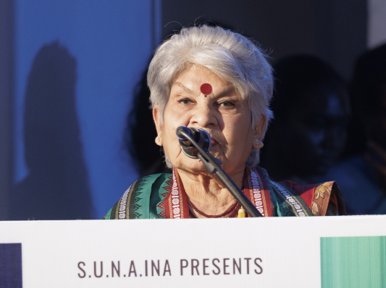
Manjari Sinha
Veteran music and dance critic Manjari Sinha put emphasis on the role of
technology in the arts, especially the live streaming of performances,
which came to the aid of performers as well as artistes during the
COVID-19 lockdowns. On the other hand, she said, there is no direct
contact between the artiste and the audiences in digital interactions.
Also, audiences have become too lazy to commute long distances, with all
the traffic snarls of city roads, only to watch a performance, when
they can sit in the comfort of their homes and watch the performance
when it is streamed.
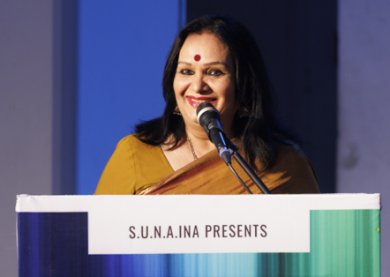
Prathibha Prahlad
Bharatanatyam exponent Prathibha Prahlad was called upon to elaborate
the terminology of 'digital'. When we talk of digital, she said, it is
not just about our technicians, that is, the people handling light,
sound and other tech-related aspects of a performance. When we think of a
performance, we first get in touch with the people who develop the
sahitya, the scriptwriters, our vocalists and musicians, and technology
comes last. Even if we have a piece that we have developed in terms of
technology, we do not always find places equipped with all the
technology and we make do with whatever we have. Technology comes to us
last. For us, dance is a temple art form and we have god as our
audience, we reach out to him. In western dance, the stage craft people,
the costume designers, sound and light are part of the initial set-up.
In the Indian dance tradition, we start training under a guru at a
tender age and by 13-14 years of age, we have a rangapravesham, after
which we step on to the stage as professionals. We teach and learn dance
and by the age of 20, we have already performed 100 to 200 times. It is
we who make our dance, not the technology.
Even at the threshold of 2024, India is not as technologically evolved
as the East or the West. So technology has to be put aside since we are
nowhere close to having all that is provided in an opera house or an
auditorium abroad. Nobody would be performing on a stage like this
(pointing to the stage). There has to be proper buffer and cushion and
then linoleum spread on it. When the internet came to the world, few
people knew about it. In the past twenty years, we have seen a sea of
change, with everything going online. There has been a digital
revolution starting with YouTube, Facebook and now Instagram and chats,
with nothing happening in the physical form and everything, all content,
based on online apps. Everything today online depends on the internet
brands - it has been 'commercialized'. The digital revolution has
impacted tangible and intangible arts in different ways. She emphasized
the need to not let the digital apps earn out of the work of our
artistes and heritage. We should not accept the culture of influencers
and two-minute 'stars' who probably dance for a clip of two minutes on
Instagram and become stars. Plagiarism is another issue she touched on,
highlighting that work that is showcased on social media is sometimes
stolen. The ideation is most important, it is plagiarized, and in India,
there are no laws to protect the copyright. She established the fact
that the discussion was about technology and not about digitization, as
in using the net to showcase your work.
Manjari Sinha responded to Prathibha's argument by narrating an incident
when Shambhu Maharaj was once asked whether he wanted a yellow light or
a red light on stage. His retort was 'Main kalakar hun,
apni kala ke prakash se nachta hun.
Tum mujhe kya prakash doge?' (I am an artiste. I dance
in the illumination of my own art. What light can you give to me?).
Manjari went on to reiterate the fact that the legacy of our arts and
their sanctity should not be compromised by the coming of technology.
Technology and digitization is meant to further the arts rather than
diluting them. The thousands of likes that a performer gets for a short
reel on the net are deceptive and the influencers and two-minute stars
on the net do not portray the artiste's proficiency.
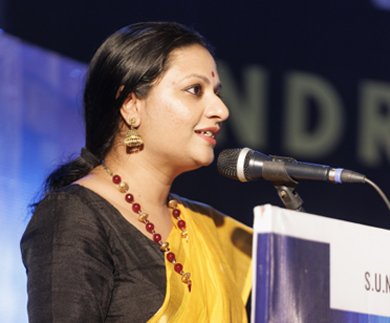
Abhinaya Nagajothy
The next speaker was Kuchipudi dancer Abhinaya Nagajothy. Abhinaya
elaborated on the subject by dividing her discourse into two categories -
historical advent of technology with reference to Kuchipudi dance, and
the present-day status of digital technology in the classical arts. She
cited the case study of technology in Kuchipudi, describing how, about a
century ago, performances were transformed radically by the
introduction of electrical supply. The use of electric lights was
adopted by theatre companies in Maharashtra, which then travelled to
Andhra to promote and introduce their systematic adoptions of technology
in the form of stagecraft, lighting and costume. Where earlier
performances could be held only in the day when there was daylight,
electrical lighting meant they could also be held after sundown. Telugu
audiences took to the new tech, and so Kuchipudi gurus at the time took
the opportunity to import these innovations into the dance form.
The advent of celluloid brought about a sea change. The audience could
work during day and be entertained at night. The sun was no longer
necessary as a source of light. Kuchipudi dancers started to act in
films and Kuchipudi songs were used in films. Vedantam Raghavaiah from
the Kuchipudi village, was the first to act in a Telugu film and went on
to become a director and dance director. Kuchipudi dancers became
choreographers for some films for classical and semi-classical numbers.
There were also films which were centred on Kuchipudi and this
encouraged young people to learn the dance form.
Another advancement was the showcasing of the classical arts on
Doordarshan channel in programs such as Nupur and Surabhi, which were
given the primetime slots. Learned, iconic gurus performed at 9pm and
11pm on TV and this brought classical dances to the comfort of the home.
State patronage helped classical dance programmes to become accessible
through TV. The IGNCA and DD are digitizing the classical arts in their
institutions, to be made available for public viewing. But now,
satellite TV programmes based on TRPs, the internet and social media
have drastically changed the pedagogy of teaching and learning the
classical dances. Now, it is the influencers who influence the arts in a
manner that has dismayed the previous generations but have allowed the
classical arts to make their way into the hearts of Gen Alpha or Gen Z.
The categorizing of production technology has been done in three parts:
pre-production, onstage technology and post-production. In the
pre-production category, the first thing that comes to mind is the
digital libraries of performances. Also, the ancient texts can be made
available in digital format for the script or ideation of a performance -
original manuscripts like the Natyashastra, Kalidasa's poetry, Sangam
poetry etc. This does not eradicate the need for actual libraries since a
choreographer has to read in order to access the different translations
and interpretations of the manuscript. The choreography can be helped
by a laptop or an iPad, where details like the placements of the dancers
can be marked prior to a performance. The colours and textures of the
textiles used in the costume can also be visualized prior to the actual
performance. Even the budget and finances can be worked out at the time
of conceptualizing.
Digital recordings of the music and audio of a piece is done for using
during the performance. Dancers can choose between live music and
recorded music. The dance has come from the streets to the stage in an
auditorium. Dancers can now choose to use a studio recording or a
recording from a previous performance of their own. This way, they also
save the cost of a live music team each time. They can perform countless
number of hours without worrying about the cost of the musicians.
Of course, the presence of the guru is very important to supervise the
practice. Short performances are better with recorded tracks since one
can use various sound effects, can enhance it at any time and add to it
at any stage. Festival organizers also prefer to have dancers using
pre-recorded tracks since it becomes much more affordable rather than
having the entire team there. Mics and mixers used in a performance,
whether live or recorded, enhance the impact of the performance. The
foot mics used can effectively make the footwork, with its intricate
taalas, be heard. Coming to lights, they can be used to enhance a
performance by introducing colours and effects. Creative use of lights
can help to transcend space and time. They can also be used to
illuminate and make the background beautiful, as in festivals held in
front of historical buildings like Old Fort, Khajuraho, Konark etc.
Stage projectors can be of great help and multimedia can be used in the
background to create different effects.
Talking about the post-performance technology, the recordings of a
performance can be viewed later and recording helps to hold ticketed
shows online. Social media remains abuzz with the videos and clips for
some time and the artiste and the performance remains in the minds of
people. One does not have to wait for the Friday reviews and reports to
know of the response. You have the clips on social media, which helps
make precise moves, to look better each time. Digital technology and
advancement have helped the arts grow and have created interest and
ambition in the younger generation to embrace the art forms and pursue
them professionally. Of course, it requires a lot of responsibility and
caution, which comes from the guru who supervises the production
process.
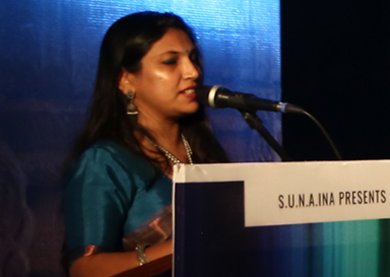
Sangita Chatterjee
Kathak dancer Sangita Chatterjee chose to talk about technology in the
context of her art. "Prathibha Prahlad has talked about how, in India,
we are lagging in terms of technology in the arts. I would like to
segregate performances into two categories: one where technology is used
to create spectacles or grandeur, and the other, where technology is
used subtly to gently complement the performance. We as classical
artistes have the edge over other art forms because we use technology
only to enhance our performance and not to create a visual treat. As
traditional or classical artistes, we have the responsibility of giving
rasaswad and rasa anubhuti to our audiences, not a spectacle that gives
only visual pleasure. I am not comfortable working on anything that
appeals to the vision only. I concentrate on anything that has content
and not simply technology. I would not want to highlight the cherry
rather than the cake. I have chosen short clips of my work to
substantiate my view. It was during the lockdown that we were relying on
technology most heavily. This is a short dance film that I created
during the lockdown. I shot the film in Delhi, the music was composed in
Kolkata and the editing was done somewhere else. This is how the
technology was used to aid a performance. Sometimes, less is more. For
my production 'Manthan', I asked my light designer to use minimal lights
and only amber and blue lights." Sangeeta emphasized her point through
clips of her productions 'Manthan' and 'Yagnaseni'. Her concluding
comment was that as a young artiste, she does not have any inhibitions
about the use of technology; she is open to using it only to enhance her
content and not to camouflage mediocrity. The first priority is to hone
your own skills.
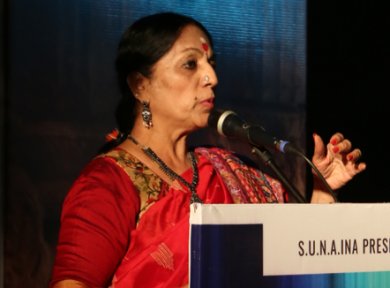
Jayalakshmi Eshwar
Taking off from what Abhinaya (or Sangita) said, Bharatanatyam exponent
Jayalakshmi Eshwar stressed on the rasa anubhuti and not rasa bhang due
to the unaesthetic use of technology. She showed clips from one of her
productions, 'Naad upasana', where minimum technology was used. The only
advanced technology she used was for music, since her music composer
was in another city. And then it was clips from another production
titled 'Antariksh'. Here, she used light and shadow to create the image
of a helicopter. The dancers recreated the spinning blades of a
helicopter using shadows, and an eagle was also shown through animation.
She showed a production in which the famous scientist Ramanujan is
going to the planet Mars. The spacecraft comes to pick him up, he sees
other planets on the way, and then the spacecraft lands back on earth.
All this was created using CGI, lights and multimedia. Here, she ended
on the note that both technology and classism work best together,
wrapped into one.
Manjari Sinha again emphasized the fact that the discussion was made
possible because of technology: Jai Ho Google guru and the web! For me,
it was an enlightening discussion. We know that science and technology
have greatly enhanced the quality of life for humans, but technology is
good as a servant when it serves our aims and makes things easier for
us. In the same way, technology in the classical arts can serve the
purpose of enhancing our performances. The moment it edges out the value
system in our classical arts and overshadows our arts, it becomes a
menace. Anyone would enjoy a concert or a performance with a good sound
system, good lighting, good aesthetic effects, but only when the artiste
is sound in their own art.
Social media - a performing artiste's friend or a foe
Photo: Anoop Arora
The next discussion had a few moments of humour too. The panellists were
Sanskrit scholar, Carnatic musician and Bharatanatyam exponent Dr. S.
Vasudevan, Kathak exponent Dheerendra Tiwari, Odissi exponent Lipsa
Satpathy and Bharatanatyam dancer Dr. Varun Khanna. Bharatanatyam dancer
Aparajita Sarma was the moderator for the evening.
Aparajita opened the discussion by saying that social media are the
tools or apps on which the artistes can share clips of their work or
images of themselves and send them across to the masses. The popular
ones in use today are Facebook, Instagram, YouTube, Twitter, Snapchat
etc. Some artistes are not tech-savvy enough to delve into these apps,
some do not want to and there are some who ride the wave of the social
media. Even huge PCs and laptops are being shunned and smartphones are
the preferred instruments of today.
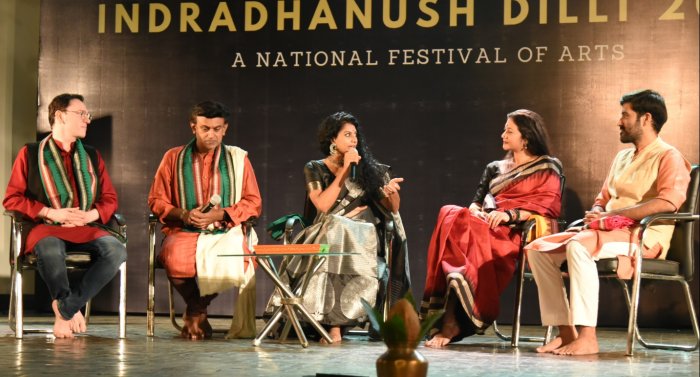
L to R: Dheerendra Tiwari, Dr.S Vasudevan, Aparajita Sarma, Lipsa Satpathy, Dr.Varun Khanna
Dr. S. Vasudevan: I am still a student when it comes to all these tools
and this digital revolution. There is no proper awareness and education
about the social media. In India, the internet is cheap and even before
we realize it, we have already shared our information with the world. I
do not think - and I am proud of the fact - that to progress in my art, I
need digital platforms. The process of my learning is very organic,
human, full of conscience and spontaneous. Everything is available to
us; we do not belong to it and vice versa. We simply use it as long as
we don't enslave ourselves to it or start to come under its spell. I
still believe in the sanctity of my art form and my thought process. The
word for it in English is creativity and in the language of dance, we
call it the manodharma. I use Instagram not out of choice but as an
obligatory official commitment, because if you do not post anything or
you do not 'like' anybody, people come to ask you whether you are still
practicing! So if you do not 'like', you are not 'live'. I feel very
sorry for the digitally blinded masses - please become aware of your
humanness. We are human bodies and not digital bodies. Imagine a world
that is free from online networks, a world that is more human than
digital. Let it be a world for art, by art and from art, through art.
Artistes are organically human bodies and minds and want to be human.
Aparajita: So if you don't post anything, it means that you are not
working. On this note, I would request Dheerendra to give us his views.
He is a dancer who does not post much on social media but when he does,
the likes shoot up.
Dheerendra: I am on every single social media platform - you name it and
I am there, whether it is Snapchat or Instagram. But I do not share too
many posts. I keep a close eye on all but I do not post anything till
it is necessary. And Prathibha Prahlad ma'am mentioned recordings - if
we do not allow phones or any other device in the auditorium, it will be
difficult to make a recording of any performance. We cannot do without
social platforms either. What we are saying is not for the general
people, it is for the people sitting here, people who practice dance,
who know the human aspect of it. We are forced to update ourselves.
Lipsa: I started appearing on social media with a profile which was
created by someone else, not by me. Gradually, I learnt to upload
pictures and videos. As artistes, we do want our work to be appreciated
and all the appreciation we get helps us. It was a gradual process and
then I thought that it was not a bad idea to be visible. It was a
meandering stream that I embraced and wanted to go with the flow of it.
Varun: I started with Facebook when I joined dental college in
Chandigarh. Chandigarh then was not so rich in its populace of classical
artistes, and I used Facebook to keep in touch with the artiste
fraternity. At present, the Chandigarh media - let's say the newspapers -
have gradually deteriorated, and there is no reporting even of the
schedule of events, when and where they are happening. As an artiste, it
was very disappointing. I would not know when and where artistes were
performing. Through social media, I learnt of performances in other
cities also and I would inform my friends and relatives in other cities
to watch the performance. And then you can post small clips or reels. It
is beneficial to artistes and to the people going to watch as well.
Snapchat is a waste of time, with all its silly filters. The most useful
are Facebook, Instagram, YouTube and WhatsApp. I am active on these
four.
Aparajita: Another point of discussion is posting when you have the
content and creating content for posting because you have to be visible
constantly. One of my friends here told me that developing content and
then posting it is a separate job in itself. Events do take place, but
not at regular intervals. But for periodic posting, you need to create
posts.
Dr.S. Vasudevan: Yes, definitely. If you have to post regularly, then
you have to create content. This is what I should be wearing, this is
how I should be photographed, this is what my makeup should be, these
are the colours I should be wearing, these are the filters I should be
using - this a separate art altogether. And as Dheerendra put it, it is a
responsibility, since you are a living, active artiste. And stress on
the 'living', because if you are an active artiste, you have to 'live'
on social media. Being active on social media is a separate engagement.
So put only the required amount of time, mind and energy into it as is
required, otherwise it is a demon that will consume you. Remember that
little is more. Be brief and short in your exposure on social media.
Just share the required amount of content.
Aparajita: Very true. And we see that Dheerendra posts very few times on
social media but when he does, it really gets a lot of hits. How do you
prepare your content?
Dheerendra: I do not develop the content; I make a video. I do not even
know how to edit a video; I have to ask one of my students to do it. I
have to add here that this is a game of pixels. At any time, we might
see Madhubala acting in a new movie. The pixels can be made to create
images. After a few years, this technology will have been developed.
Every artiste should be cautious in whatever he or she is creating,
because after a few years, our pixels will be dancing. I have an example
to give. A little while back, I had gone to Ludhiana, one of the
richest cities in India. One filthy rich lady comes to Sangita didi in a
Bentley in full style. She told didi that she has told her friends she
is learning Kathak, she wants a 30-second reel to post on social media
and she is ready to give that much money for it. In three days, didi
taught her to do ek do teen chaar footwork and the sound of the
ghunghroos and footwork didi was giving from behind. In 30 seconds, the
lady lived her Kathak dream by making a reel.
We should be responsible and choose our audience, whether we want
millions of followers or a few thousands. I don't create fancy videos or
try to sing or do something different. People are very smart, they
create a content bank. Those who do this are more visible and earn
through it. If I post some content for 3 days, the fourth day the app
starts asking me, hey Dheerendra, do you have something on your mind? It
is a beautiful medium but it has to be used wisely.
Aparajita: Varun, how do you create content for your reels and other platforms?
Varun: Creating content for social media is like creating for the live
audience. It involves a creative thought process, mind work and hard
work. A few years back, I lost my father. I was without work, sitting at
home without knowing what to do. I started making short videos anywhere
in the house, even in my garden, and started sharing them on social
media.
Aparajita: He did 100 days of dance and posted a reel every day. That was a marathon.
Varun: It is not easy to do. It requires shooting, editing, giving captions to the sahitya and making it interactive.
Aparajita: All of us artistes here face the issue of copyright. We put
out our pictures, our videos and our work out there on social media
platforms and it can be plagiarized. As Dr. Anita Ratnam said, if you
want to share your work, you must share it right from scratch, otherwise
it will be picked up by somebody else. So how do you go about it? Has
your work been copied and how can you protect it?
Lipsa: If you ask about my personal experience, no, it has not happened
to me. But we should not be so careless about sharing our work.
Sometimes our music is picked and used to make a video on YouTube, which
may not be a classical performance at all. So, one has to be extra
cautious. We have to be very careful about the copyright issues and
protect our work from being copied by unscrupulous people and put to
wrong use.
Aparajita: As the discussion comes to an end, we can summarize that
social media is neither our friend nor our foe. But it is there and we
cannot deny its existence. We have to update ourselves, like we have
from live orchestra to records, cassettes, CD, pen drives, laptops,
mobiles and many more technological advancements in the future. So be
mindful, don't be so pushed, just gradually meander through it and
embrace it finally, like the younger generation of dancers.
The two discussions were very thought-provoking. I felt that all the
speakers had presented their views well, with many images and
information to back their opinions. The two moderators were also very
eloquent. The classical arts have been around from the time mankind
evolved. They are still the bearers of the cultural evolution and will
always be there in the future as well. If any technological development
helps in enhancing them, it should be included immediately. The
technology is for the dance, but we don't need to either dance for
technology or let technology rule our arts. Social media is just like
the physical form - social gatherings. If it works for you, fine, go
with it, and if doesn't, just excuse yourself from the party.
Note: This article/report first appeared in narthaki.com


Comments
Post a Comment